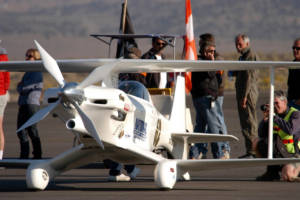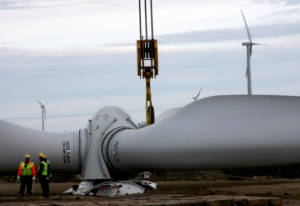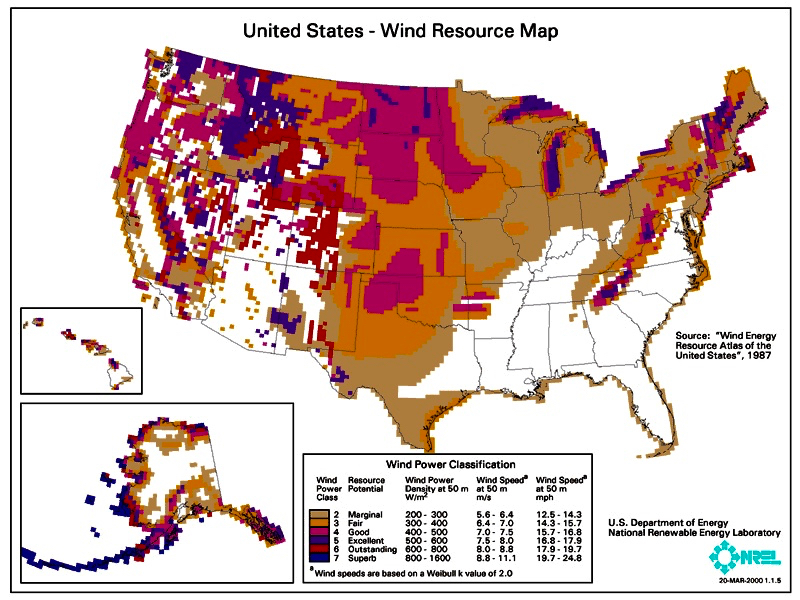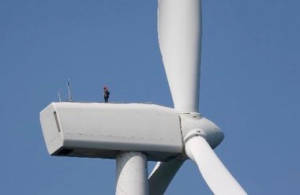Why wind turbines have three blades
Steve Jobs
" You know throughout the years in business I found something which was I'd always ask why you do things and the answer you invariably get is oh that's just the way it's done. Nobody knows why they do what they do. Nobody thinks about things very deeply in business. That's what I found"
The quote above from just over 17 minutes into Steve Jobs - The Lost Interview is for me the greatest insight and the biggest idea in the whole movie. I find myself applying it to many things. You can, too. Just ask why?
In this column I'll try applying the principle to one example of renewable energy - wind power. Why, when it comes to windmills, wind turbines, wind generators - whatever you want to call them - why are things done the way they are? The answers may surprise you.
I had a friend named Paul Lipps who died suddenly a few years ago, taking from the world a true genius when it came to many things but especially propellers and anti-propellers, which is what wind turbines are because rather than accelerate air they slow it down, taking power from the wind. At the time of his death I was trying to interest Paul in revolutionizing the wind turbine industry based entirely on asking why?We never got to do it, but we did answer some of the most important questions.
Paul Lipps designed propellers that looked unlike any others because he didn't care how they looked, just how they functioned. His greatest success was in the Sport Biplane class at the Reno National Air Races, where one year the race plane for which he'd designed a propeller increased its top speed by 51 miles-per-hour with no change beyond the propeller. Nothing else was different from the year before. That race plane hasn't lost a race" ever.

World's fastest biplane
When we sat down to invent a new type of wind turbine it all began with a single question why: why do large wind turbines invariably have three blades?
In the case of this question the answer wasn't "because that's the way it has always been done." The answer was, instead, "because we have a mathematical proof that three turbine blades extract the most energy from the wind stream."
"The most energy," in this case refers to the maximal efficiency of any wind turbine as calculated in 1919 by Albert Betz of Germany. According to Betz's Law, no turbine can capture more than 16/27ths or 59.3 percent of the wind energy passing through the turbine disk. So 59.3 percent is the best you can hope for" or is it? In practical terms the best commercial wind turbines reach 75-80 percent of the Betz limit or no more than 48 percent total efficiency.
Yes, but why three blades?
The conventional answer to this question is that three blades minimizes the shadow effect that each leading blade has on the blade that follows. You want more blades to reduce the starting torque required to get your turbine spinning (this is analogous to having more cylinders in an engine making it run smoother) but if you have too many blades the shadow effect hurts efficiency and drops the total yield. Three blades peak at about 48 percent efficient, which isn't 59.3 percent but is near enough and happens to be the practical output I mentioned two paragraphs ago. So it must be right, right?
Put another way, Rotor power = 2I M n is proportional to the torque M acting on the shaft and the rotation frequency n. The tip speed ratio I = vu / v1 from the ratio of tip speed vu of the rotor and the wind speed v1. Optimal tip speed ratio is 7-8 for the three-bladed rotors where they achieve a cp value of 48 percent. Four blade turbines have higher torque but lower tip speed ratios. Turbines with two blades have even higher tip speed ratios but lower torque. In the end, three-blade turbines command the sweet spot and so that's what are built.
It all sounds good but everything is dependent on total belief in Betz's Law and in the concept of blade shadows. Only Paul Lipps didn't believe in blade shadows. The more blades the better in Lipps's view because the turbine blades are in a moving column of air. And even Betz's Law is incorrectly applied in these examples because what matters isn't power efficiency per turbine so much as power production per acre of wind farm.
If you are building a wind farm, what counts above all else is how many kilowatt- or megawatt-hours per year can your wind farm produce and that's a function that goes far beyond Betz and three blades.
Conventional wisdom says wind farms should have their turbines placed in such a way that they don't interfere with each other, the fear being that placing one turbine too closely in the shadow of another will reduce the efficiency of the showed turbine. The rule of thumb, then, is that turbines be placed no closer than seven diameters apart. Keep that number in mind.
Now a word about computational fluid dynamics (CFD), super computers, and how wind fields are designed. You'd think it would be all about CFD but it isn't. Turbines are designed with three blades and those blades should be as long as practically possible with the turbines mounted on towers that are as tall as possible to get out of ground effect and into faster-moving air. Oh, and turbines are placed seven diameters apart. That's it, no CFD. This is because past experiments in CFD modeling wind farms haven't gone very well. "It just doesn't work," we were told over and over again.
Shouldn't that be a clue there's something wrong with the popular methodology?
One other point to ponder is why, when you drive past a wind farm, very often the turbines aren't turning at all? This is because they use alternators that consumer electrical power to energize their windings so there is no point in turning-on the alternator (energizing those windings) until there's enough wind to generate a net positive amount of electricity. You can get around this by using permanent magnet generators instead of alternators, but those are more expensive, requiring rare earth magnets.
If you happen to drive past a wind farm in the middle of a storm you'll further notice that the turbines are stopped then, too, to avoid damage from high winds and too-fast rotational speeds. The result of all this not starting and then stopping is that throughout the year an average workload of 23 percent is reached by inland wind farms, 28 percent for coastal farms and 43 for off-shore. Even offshore wind farms have their turbines actually generating electricity less than half of the time.
All this not generating requires a lot of control, too. Wind farms are generally networked together and under computer control. In some cases wind farm automation can cost as much as the turbines, themselves. It's a major maintenance headache, too.
 One last point about conventional wind farms before I start to build toward my boffo conclusion: they are biased toward very large industrial organizations. General Electric, for example, is big in wind power. All the top companies are big because look at what they are creating - huge farms of enormous wind turbines built at immense cost and controlled to the millisecond. No little companies need apply. Try breaking into the industrial wind power business without at least $1 billion in capital. It can't be done. The incumbent companies like it that way, too.
One last point about conventional wind farms before I start to build toward my boffo conclusion: they are biased toward very large industrial organizations. General Electric, for example, is big in wind power. All the top companies are big because look at what they are creating - huge farms of enormous wind turbines built at immense cost and controlled to the millisecond. No little companies need apply. Try breaking into the industrial wind power business without at least $1 billion in capital. It can't be done. The incumbent companies like it that way, too.
But there's a better way to build wind farms. First, make the turbines smaller and with a lot more than three blades. Twelve blades is a nice number. And make those blades no more than 40 feet in length because that's the length of a full size shipping container. This enables true mass production of blades and turbines in large centralized factories at considerable cost savings.
China will build the heck out of those smaller blades.
Because they are smaller you will need more of these Lipps turbines to fill your wind farm than you would those huge 100+ meter wind turbines. You still want to put the little turbines on tall towers, but because the turbines are smaller the towers can be lighter, too. And put them closer together - a lot closer together than seven diameters. There's a way to position them that actually increases output from the field. Remember the diameters are smaller so instead of hundreds of turbines we're talking about thousands of turbines for the same wind farm. Imagine a field of mature dandelions.
Shorter blades are stronger than longer blades, so the Lipps turbines can operate in faster winds. More blades mean lower starting torque so the Lipps turbines can operate in slower winds, too, so that 23/28/43 percent of active generating could be expanded considerably. Use permanent magnet generators and the turbines could be allowed to run 24/7 in any wind with no computer control required at all, leading to more production at even lower cost.
Now it is time to iterate. We have smaller turbines with four times as many blades built at much lower cost and installed in much higher density and generating 24/7 in both higher and lower winds. What impact would those design changes have on wind farm site selection? Well it would dramatically expand the areas suitable for wind farms, which tend to be far away from the very people and businesses intended to consume the power. Lipps wind farms could be closer to cities and therefore have lower transmission losses, further increasing power output.
Our calculated result of a Lipps wind farm compared to the same farm using current state-of-the-art wind turbines and control is the Lipps farm would cost no more (probably less) and generate 5-8 times as much power per acre per year, all without violating Betz.
And no insane cows, either. Cattle can't be pastured under wind farms because the motion of the turbine blades and especially their sound drives cows crazy. Lipps turbines with their 12 shorter blades have a much less obtrusive higher frequency sound that cows don't seem to notice.
That's a lot of ideas from just asking why.
Alas, it didn't happen because Paul Lipps died. His heirs chose to continue only one Lipps product line - propellers for drones. If you want a Lipps prop for your drone, you'll have to buy it from Boeing, the sole source.


Digital Branding
Web DesignMarketing
